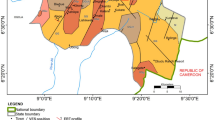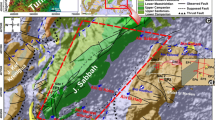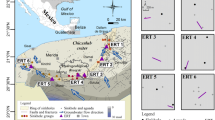Abstract
As part of a larger regional research program “KarstEAU”, the authors have applied electrical resistivity tomography (ERT) techniques to characterize heterogeneities in the Port-Miou coastal karst aquifer (Cassis, SE France). Field surveys were carried out on intensely fractured and karstified Urgonian carbonates. Extensive research has characterized macro- and micro-scale geology of the Port-Miou area and particularly underground water-filled conduits and fault/fracture and karst systems within a former quarry. The authors applied 2D ERT along two surface profiles of length 420 and 595 m to test capability for delineating subsurface conduits and possibly relationship between conduit and fault/fracture/karst orientation; and 3D ERT with a dense 120 electrode array at 1 m spacing (11 × 10 m) was applied over an area of the quarry that had been profiled using 3D georadar and which has had intensive nearby structural geological interpretation. The 2D profiling imaged several underground conduits at depths to >50 m below ground surface and below sea level, including possibly the main Port Miou submarine spring and smaller springs. The 2D profiling within the quarry provided a better understanding of the connectivity between major fractures and faults on the quarry walls and secondary springs along the coast supporting flow of the secondary springs along interpreted fracture orientations. In addition, 2D inversion-derived conductivity models indicate that high resistivity zones above sea-level are associated with non-saturated zones and low resistivity anomalies in the non-saturated zone are associated with residual clays in paleokarsts. A partitioned lower resistivity zone below sea-level can be associated with a higher porosity/permeability zone with fractures and karstic features. Inversion models of the dense 3D ERT data indicate a higher resistivity volume within the larger surveyed block. The survey characterized the non-saturated zone and the ERT resistivities are correlated with karst features interpreted by 3D georadar and visible in the inferior wall of the quarry.







Similar content being viewed by others
References
Cornet G, Durozoy G, Gouvernet Cl, Munck F (1964) La source sous-marine de Port-Miou (Calanques de Cassis) Etude par prospection géophysique. Livret-guide hydrogéologique, 8–9 et 10 Juin 1964. BRGM
Daouddi B (2009) Formations “post-urgoniennes” dans deux depressions du Massif des Calanques (de Marseille à Cassis). Aix-Marseille Université, Mémoire de Master
Darnault CJG, Godinez IG (2008) Overexploitation and contamination of shared groundwater resources. In: Darnault (ed) Coastal aquifers and saltwater intrusion. Springer Science + Business Media B.V, Dordrecht
Eso R, Oldenburg D, Maxwell M (2006) Application of 3D electrical resistivity imaging in an underground potash mine SEG Expanded Abstracts 25:629
Floquet M, Hennuy J (2003) Evolutionary gravity flow deposits in the Middle Turonian-Early Coniacian Southern Provence Basin (SE France): origins and depositional processes. In: Locat J, Mienert J (eds) Advances in natural and technological hazards research, submarine mass movements and their consequences, vol 9. Kluwer Academic Publishers Book Series, Dordrecht, pp 417–424
Ford DC, Williams PW (2007) Karst geomorphology and hydrology. Chapman and Hall, New York, 601 p
Jayet O (2009) Les faciès de fracturation dans les roches carbonatées : typologie, contrôles sédimentologiques et propriétés pétrophysiques (Crétacé inf. Bassin Sud Provençal). Mémoire de Master 2, Aix-Marseille Université, France
Lamarche J, Jayet O, Lavenu A, Gauthier B, Guglielmi Y, Demory F, Masse JP, Marie L (2010) Mechanostratigraphy and fracture facies in lower Cretaceous carbonates of Provence (SE-France): EGU Meeting
Martel EA (1907) Sur un projet d’utilisation de la source sous-marine de Port-Miou (B. du R). Annales de l’hydraulique agricole. Fasc.36 bis
Masse JP, Fenerci M, Pernarcic I (2003) Palaeobathymetric reconstruction of peritidal carbonates late barremian, urgonian, sequences of provence (SE France): palaeogeography. Palaeoclimatoly. Palaeoecology 200:65–81
Philip J (1972) Paléoécologie des formations à rudistes du Crétacé supérieur - L’exemple du Sud-Est de la France. Palaeogeogr Palaeoclimatol Palaeoecol 12(3):205–222
Pomar K (2010) Visualization and quantification of fractures and karst in Cretaceous carbonates, Cassis. Master of Sciences, University of Miami, France, 105 p
Potie L, Ricour J (1974) Etudes et captage de résurgences d’eau douce sous-marines. Ressources en eau pp 5–26
Revil A, Hermitte D, Spangenberg E, Cochemè JJ (2002) Electrical properties of zeolitized volcaniclastic materials. J Geophys Res 107(B8):2168. doi:10.1029/2001JB000599
Tassy A, Arfib B, Gilli E (2010) Access to coastal karst resources through a salinity study during an exceptional high-water event: the case of Port-Miou (SE France). Advances in Research in Karst Media. IVe Symposium on karst, Malaga, pp 49–55
Acknowledgments
This work is part of KarstEau project, funded by the “Agence de l’Eau Rhône-Méditerranée-Corse”, the “Conseil Général du Var”, the “Conseil Général des Bouches-du-Rhône”, and the “Région Provence-Alpes-Côte d’Azur”. Authors are grateful to Jan Borgomano, Clément Ciocca, Loïc Pantaine, Thomas Maggiore and Michel Tassy for the collaboration in the ERI surveys. Thanks to the Cassis town hall for facilitating the activities in the study area.
Author information
Authors and Affiliations
Corresponding author
Rights and permissions
About this article
Cite this article
Tassy, A., Maxwell, M., Borgomano, J. et al. Electrical resistivity tomography (ERT) of a coastal carbonate aquifer (Port-Miou, SE France). Environ Earth Sci 71, 601–608 (2014). https://doi.org/10.1007/s12665-013-2802-4
Received:
Accepted:
Published:
Issue Date:
DOI: https://doi.org/10.1007/s12665-013-2802-4




